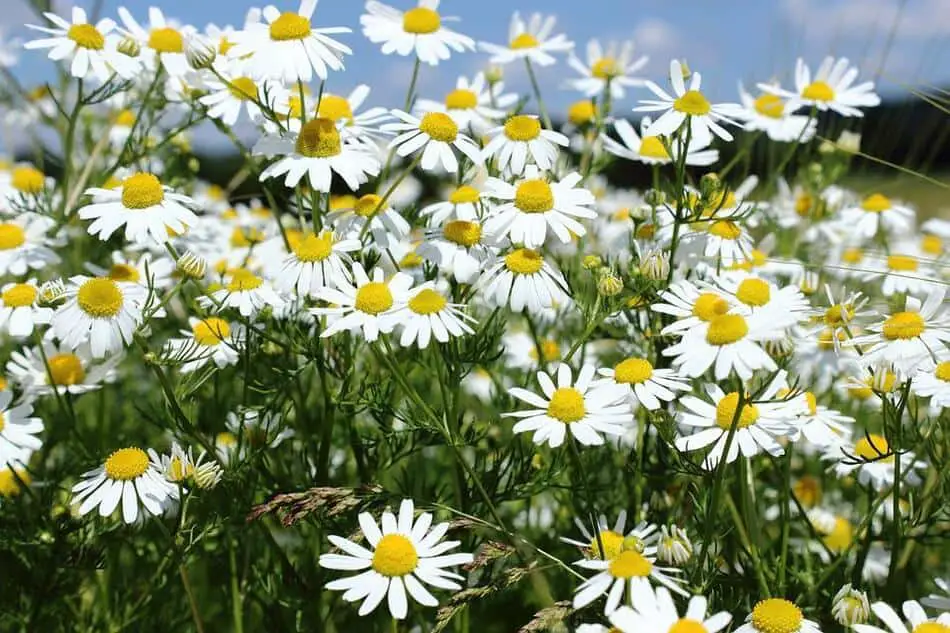Feverfew tea has been used for many years as a folk remedy to reduce a fever as well as relieve the symptoms of a migraine headache. It grows well in most parts of the United States, and the leaves can be consumed fresh or dried. Feverfew is available at health food stores or herbal medicine shops in both fresh and dried forms. So, how to make feverfew tea. Let me tell you the recipe.
My feverfew recipe is quick and easy! In fact, it will be ready within 10 minutes. Enjoy this soothing tea on a fine afternoon. All you need are fresh feverfew and your kettle.
Now, let us dive into the details.
How To Make Feverfew Tea?
Let me tell you how to make feverfew tea.
- Remove the leaves of fresh feverfew and chop or tear them into small pieces.
- Place 1 tsp. of leaves in a tea ball. Fill a cup halfway with water and add the tea ball.
- 1 cup of boiling water should be poured over the tea ball.
- Allow five minutes for the tea to steep.
- Remove the tea ball and drink the tea while it’s still hot.
Feverfew is a lovely, cheerful flower with several useful medicinal uses. This plant is a wonderful addition to any herbal garden, from preventing headaches to assisting with menstrual difficulties.
Tips To Make Feverfew Tea
Now, I have some tips for you to make feverfew tea.
- Both the flowers and leaves can be used to prepare the tea, although there is more study on the use of leaves.
- Feverfew is a perennial herb that can grow in almost every soil type, although it prefers loamy and dry soil. Before sowing, freeze the seeds for one week. Only the top 6 to 8 inches of the plant should be harvested.
- At most health food stores, you may find Feverfew tinctures, syrups, capsules, and tablets.
- Feverfew leaves may be eaten in moderation and serve the same purpose as tea, according to some sources.
- The effectiveness of feverfew in treating some types of pain has been studied. It has exhibited promise as an antispasmodic.
- Feverfew has been used in folk medicine to treat arthritis pain, but there is no scientific evidence to support this claim.
Now, let me briefly learn about the history of feverfew.
History Of Feverfew
Feverfew has long been used to relieve migraine, arthritis, and menstrual and childbirth discomfort. It may be found in Europe, Australia, and North America today. However, it was originally discovered in southeast Europe.
Feverfew has had numerous names throughout history, making it difficult to locate in older texts. Parthenon is one feverfew-like plant that historians believe existed.
Parthenon is a name derived from the Greek term for “maidenly.” It was most frequently used to treat uterine ailments, although it has been connected to at least three different herbs! Feverfew is one of them.
Parthenium is a plant that’s also known as feverfew. It was formerly used to save the life of a slave who fell from the Parthenon, Athena’s famed temple, during its construction in the fifth century BC.
The plant was first used as an antipyretic by the Greeks in the 1st century, and it is still utilized for this purpose today. Feverfew was known as medieval aspirin during the 18th century.
Although it was not introduced until the mid-nineteenth century, it was nevertheless utilized throughout the Western Hemisphere. The herb was used as a digestive aid, a cardiac tonic to stimulate the heart, and an enema for parasites in Costa Rica.
Feverfew has long been a popular remedy for women, with Costa Rican and Mexican women both using the plant to assist with menstruation. Feverfew is a well-known treatment for fevers.
What Are The Benefits Of Feverfew?
Feverfew isn’t very helpful in reducing fevers, despite its name and history. Despite this, feverfew has a number of advantages. Here are some ways to utilize this plant medicine.

Feverfew For Migraines
Since the 1970s, feverfew has been used to treat headaches and migraines. Feverfew is shown to not only reduce the severity of migraines but also the frequency when taken on a regular basis. It can also aid in the relief of nausea caused by migraines.
However, for individuals who suffer from chronic headaches, magnesium is best utilized as a preventative measure rather than a cure-all.
Feverfew Has Anti-inflammatory Properties
Its anti-inflammatory qualities make it useful for treating migraines. This implies that it may also be used to treat diaphragmatic problems. Some of these problems are coughing, phlegm, pain that is associated with arthritis, and general pain relief. Moreover, feverfew helps with chest congestion and asthma.
Feverfew Helps With Menstrual Issues
Feverfew has long been used to treat menstrual problems. It can assist with deficiency, scanty periods, and delays, as well as clots and overabundance. It may also be utilized to relieve menstrual discomfort and spasms. Feverfew is also useful in treating menopausal symptoms like hot flashes, mood fluctuations, and night sweats.
Growing Feverfew Plant
Feverfew herb seeds are readily available through mail-order catalogs or in local garden stores. It’s confusing enough that the plant is known by both Tanacetum parthenium and Chrysanthemum parthenium, but it gets even more complicated. The seeds are tiny and easiest planted in tiny peat pots containing damp, loamy soil.
Growing Feverfew Through Seeds
Sprinkle a few seeds into the vessel and tap the bottom of the container on the counter to settle them into place. Pour water over the seeds to keep them wet, but don’t worry if some of them slip out; it’s normal.
You should notice the feverfew seeds germinating after two weeks if they’re placed in a sunny window or under a grow light. Plant the plants, potted and all, into a sunny garden location when they are approximately 3 inches (7.5 cm.) tall, then water them as needed until their roots grow firmly.
If you choose to grow feverfew in the garden, follow these steps. In early spring, sow the seed while the earth is still chilly. To ensure that the seeds make full contact with the soil, sprinkle them over it and lightly press them down.
Covering the seeds will result in them not germinating. Water by spraying rather than washing to prevent the seeds from flying away.
In about 14 days, your feverfew plant should sprout. Thin the plants to 15 inches (38 cm.) apart when they are 3 to 5 inches (7.5-10 cm.) tall.
If you want to cultivate your feverfew plant outside of an herb garden, the only requirement is that it receives enough sunshine. They prefer loamy soil, but they are not picky. Indoor plants become leggy, but outdoor pots keep them compact.
Feverfew is a perennial plant that grows back every year after being cut back to the ground in the fall. It re-seeds easily, so you may wind up with new plants for a few years. The feverfew herb blooms between July and October.
Final Thoughts
Now, you can easily make feverfew tea through my simple recipe stated above. This tea offers several health benefits that you can avail yourself of.
Read More!
Learn how to Grow Feverfew?
How to Make Cinnamon Oil?
What Color is the Rosehip Oil?
Know about the smell of lavender oil!
What blends well with Peppermint Essential Oil?


